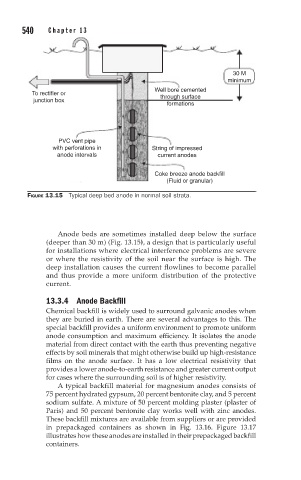Page 577 - Corrosion Engineering Principles and Practice
P. 577
540 C h a p t e r 1 3 C a t h o d i c P r o t e c t i o n 541
30 M
minimum
Well bore cemented
To rectifier or through surface
junction box
formations
PVC vent pipe
with perforations in String of impressed
anode intervals current anodes
Coke breeze anode backfill
(Fluid or granular)
FIGURE 13.15 Typical deep bed anode in normal soil strata.
Anode beds are sometimes installed deep below the surface
(deeper than 30 m) (Fig. 13.15), a design that is particularly useful
for installations where electrical interference problems are severe
or where the resistivity of the soil near the surface is high. The
deep installation causes the current flowlines to become parallel
and thus provide a more uniform distribution of the protective
current.
13.3.4 Anode Backfill
Chemical backfill is widely used to surround galvanic anodes when
they are buried in earth. There are several advantages to this. The
special backfill provides a uniform environment to promote uniform
anode consumption and maximum efficiency. It isolates the anode
material from direct contact with the earth thus preventing negative
effects by soil minerals that might otherwise build up high-resistance
films on the anode surface. It has a low electrical resistivity that
provides a lower anode-to-earth resistance and greater current output
for cases where the surrounding soil is of higher resistivity.
A typical backfill material for magnesium anodes consists of
75 percent hydrated gypsum, 20 percent bentonite clay, and 5 percent
sodium sulfate. A mixture of 50 percent molding plaster (plaster of
Paris) and 50 percent bentonite clay works well with zinc anodes.
These backfill mixtures are available from suppliers or are provided
in prepackaged containers as shown in Fig. 13.16. Figure 13.17
illustrates how these anodes are installed in their prepackaged backfill
containers.

